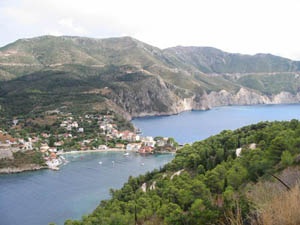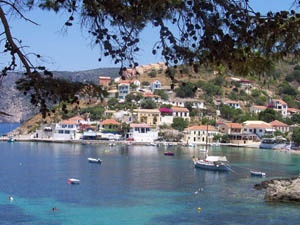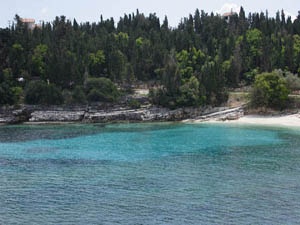|
 |
The municipality of Erisos
covers the northern part of the island and is well-known for its
unique beauty.
The road network joins all the villages of the region, passing
through idyllic countryside and linking up with the main roads of
the island.
Driving along the high mountain roads, you have a stunning view of
the small harbours and bays far below you.
Along the way, you can visit the famous village of Assos, the
capital of the island in 1593 and main harbour of the region, with
its 16th century Venetian castle and old rural prisons, which were
in operation untill 1953.
View photos of the region
|
|
view
photos of the region
|
ΗThe road to Fiscardo
takes you near the Monastery of the Virgin Mary (Paliohersos), which
dates from 1600 and is situated 2Km from the village of Defaranarata.
The church holds a feast day on 8th September and it houses an icon
called “Platitera of the Heavens”.
Along this road you will find very beautiful, small villages that
are characterized by their exceptional pre-earthquake architecture,
since many of the buildings were not destroyed by the 1953
earthquake.
|
|

|
FISCARDO
Fiscardo, an old fishing village whose houses remained intact after
the 1953 earthquake, is today one of the most famous tourist resorts
in Greece.
Providing shelter and mooring for many boats, it is one of the
best-known areas for marine tourism at both a domestic and
international level.
Roberto Guiscard, the Norman crusader for whom the village was
nameed, reached here in 1085 with the intention of occupying the
island, and stayed here untill his untimely death.
Most of the region's manor houses date from the Venetian occupation.
|
|
Fiscardo is famous for its
quaint streets as well as its cosmopolitan character. It was the
birthplace of Nikos Kavvadias, a poet-cum-sailor who wrote about the
sea.
It is surrounded by picturesque villages, beaches with crystal clear
waters and the splendid cypress groves of Evreti. To the east, the
villages and hamlets, with their view of the island of Ithaka, are
testimony to the developments that have taken place and will
continue to do so in the future.
The whole region of Erissos is widely-known as an area of
outstanding natural beauty.
Fiscardo itself is divided up into smaller areas: Apolitos (where
the ferry comes in), Larni (near Spiliovouno), Kaminakia, Zavalata
and Foki.
In the area surrounding Fiscardo you can see many traditional and
extremely beautiful villages, such as Antipata, Germenata,
Psilithrias, Magganos, Katsarata, Matsoukata, Tseledata, Barzoukata,
Tzamarelata, Agrilias, Halikeri and many others.
|
| |
|
|

|
ΑASSOS
One of the most picturesque regions of the island and an extremely
popular resort, which plays host to many tourists in summer. Shaped
liked a semi-circle round the bay of Assos, the beautiful beach
allows those who love the sea a chance to cool off.
The village streets are lined with beautiful houses and gardens full
of flowers, presenting a picture of part of the island untouched by
the modern world.
|
|
There are however, all the
modern facilities a tourist could wish for, with shops and tavernas
located in the central square under the branches of the plane tree
and oleanders.
The beautiful castle of Assos, with its panoramic view of the Ionian
Sea and its long history, is the region's jewel in the crown.
Construction began in 1585, following a request from an envoy from
Kefalonia to the Venetian authorities, asking for better protection
of the island.
This mound was suggested because of its steep slopes and relative
invulnerability to attacks from the sea.
Assos became the capital of the northern part of the island in 1593,
and the castle we can see today is perfect example of the
Renaissance art of fortress building.
The castle was used as a rural prison until 1953. You can still see
the ruins of the 2Km castle walls, the remains of the residence of
the Venetian Governor, barracks and the church of Saint Mark.
Restoration work is beeing carried out at the present time.
|
|
|
|
AGRILIA
An area which takes you back in time. The age of the houses alone
shows you how old the village really is.
It is located in the north-west of the island, bordering on Maggano,
from where a road leads to the busy fishing village of Fiscardo,
Tzamarelata and Halikeri.
The houses were built after the earthquake, although you can still
see some abandoned houses from before 1953. There is a wide variety
of lush green vegetation to tempt nature lovers, who will enjoy the
enchanting landscape of olive trees, cypresses, and lemon and orange
groves that cared for by the few residents of the area.
LARNI REGION
Here you can find the "Throne of Queen Guiscard or "Fiscarda"- a
carved niche in a rock with intricately carved steps and seats. It
is believed to have been a grave or an ancient place of worship.
SPILIOBOUNO
To the west of Fiscardo, a part of a Cyclopean wall which was built
in ancient times for defense purposes. |
| |
|
 |
BEACHES
Zavalata, Foki, Emplisi, Kimilies, Alaties. St Jerusalem, Evreti,
Tholiha, Halasmeno Karavi and many more.
|
|
|
|